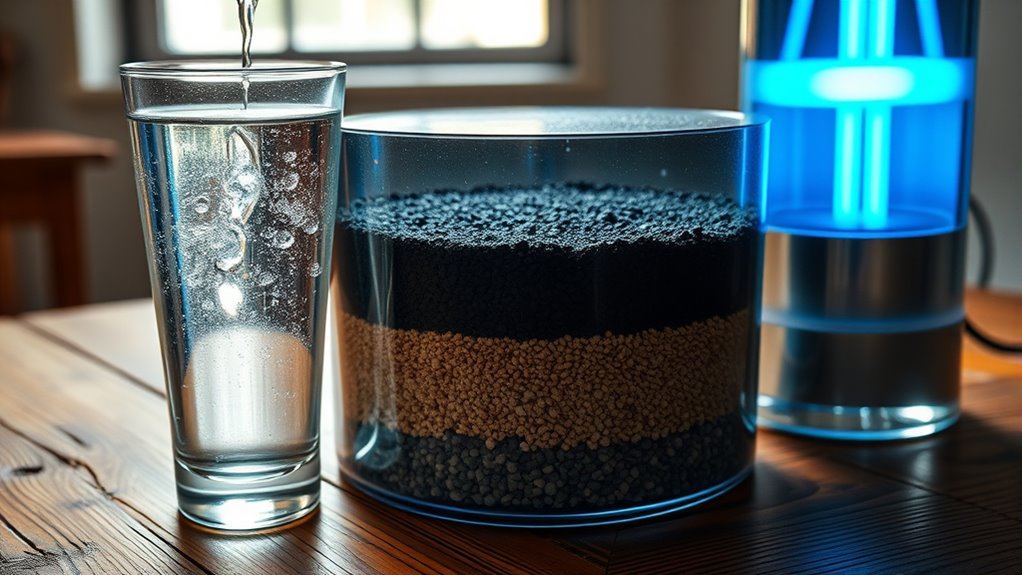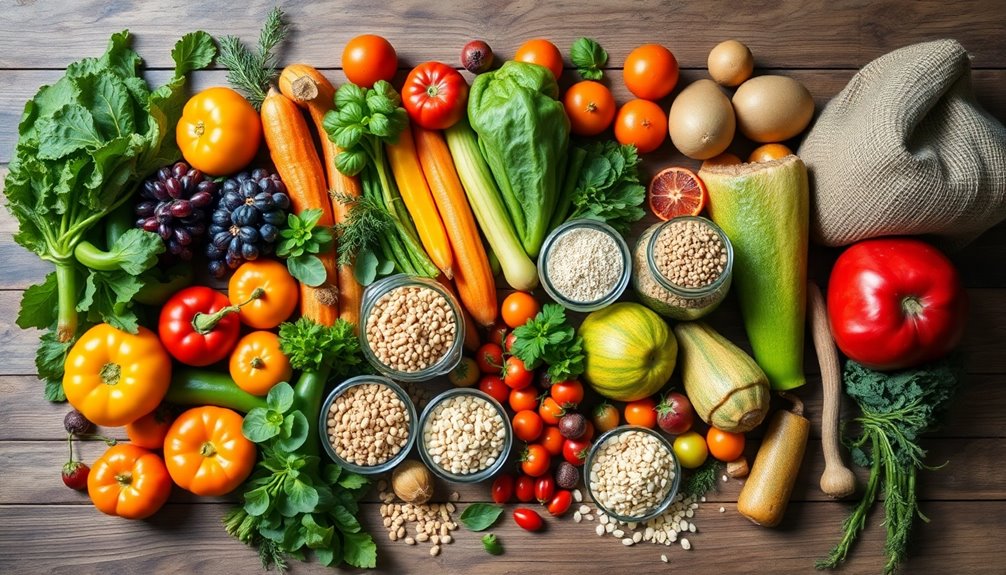Water purification methods include boiling, filtration, distillation, and disinfection to remove contaminants, pathogens, and pollutants. Boiling kills bacteria and viruses, while filtration systems like activated carbon and ultrafiltration clear particles and chemicals. Distillation heats water to vaporize impurities, then condenses it into clean water. Disinfection methods such as chlorine, UV light, and ozone guarantee water safety. To learn how these techniques work together and their maintenance, keep exploring further.
Key Takeaways
- Water purification techniques include filtration, biological processes, chemical treatment, distillation, and disinfection methods like UV and ozone.
- Filtration removes particles, sediments, and some microorganisms using systems like activated carbon, ultrafiltration, and sand filters.
- Chemical treatments, such as chlorination, disinfect water by killing pathogens, while UV and ozone inactivate microorganisms without chemicals.
- Distillation heats water to vapor, leaving contaminants behind, then condenses it into pure water, effective for removing salts and heavy metals.
- Combining multiple methods, like filtration plus chemical or UV disinfection, enhances overall water safety and contaminant removal.
Why Is Water Purification Important?

Water purification is essential because it removes harmful chemicals, pathogens, and pollutants that can make water unsafe to drink. Without proper water treatment, contaminants like bacteria, viruses, and chemicals can cause serious health issues. Using effective filtration methods helps ensure you get safe drinking water, reducing the risk of waterborne diseases such as cholera and diarrhea. Globally, over 2 billion people lack access to clean water, making water purification crucial for public health. Simple techniques like boiling and filtration can considerably cut down health risks associated with contaminated water. Additionally, understanding water quality is vital for selecting the most appropriate purification methods for different environments. By understanding water quality and employing appropriate purification methods, you protect yourself and others from preventable illnesses. Clean water is fundamental to health, and proper water treatment is key to achieving it. Advances in water treatment technology continue to improve purification efficiency worldwide.
How To Test Water Quality?
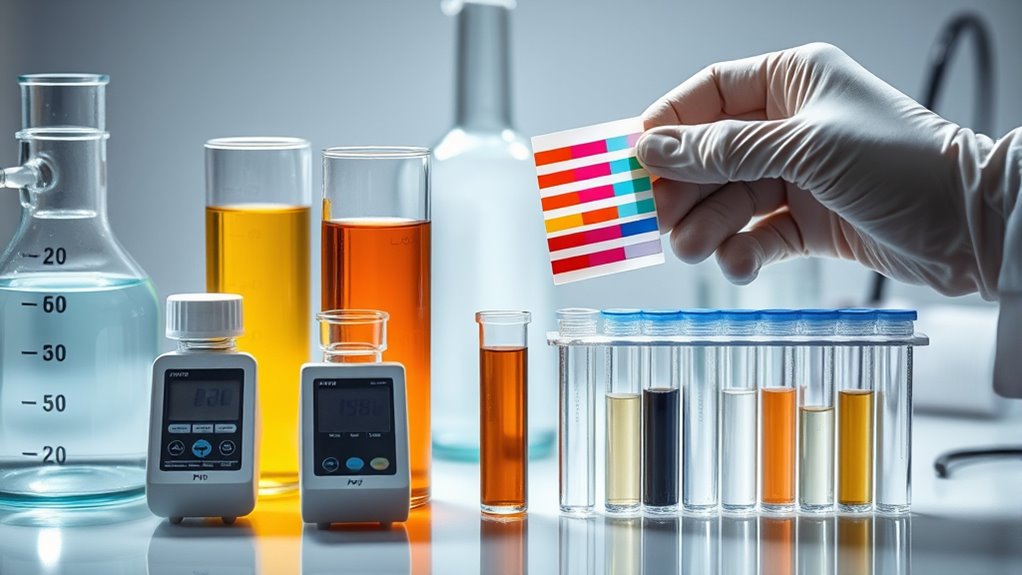
Ever wondered how you can determine if your water is safe to drink? Water testing is vital for evaluating water quality. You’ll want to analyze variables like turbidity, pH levels, dissolved oxygen, and contaminants such as metals, chemicals, and microbes. Using chemical test kits, portable sensors, or lab analysis, you can detect pollutants accurately and guarantee your water meets water quality standards like EPA guidelines. Proper sampling is essential—collect water from representative points in sterile containers to get reliable results. Advanced methods like membrane filtration and spectrophotometry help identify specific pathogens, heavy metals, and chemical pollutants at trace levels. Modern testing techniques enhance water safety monitoring and help you detect emerging pollutants more efficiently. Regular water testing allows you to spot pollution sources and verify the effectiveness of purification efforts, keeping your water safe to use. Incorporating modern testing techniques enhances water safety monitoring and ensures compliance with health standards. Additionally, understanding AI in education can improve the interpretation of complex data from water testing devices, leading to more accurate assessments. Recognizing water quality standards is crucial for setting appropriate testing parameters and ensuring public health safety.
What Methods Are Used To Purify Water?

Have you ever wondered how contaminated water is transformed into safe, drinkable fluid? Several methods work together to purify water effectively. Filtration removes particles and sediments, while biological processes like slow sand filters eliminate bacteria naturally. Chemical treatment, such as chlorination or iodine, kills pathogens and disinfects the water. Reverse osmosis and ultrafiltration use membrane technologies to remove dissolved solids, bacteria, and viruses. Disinfection methods like UV light and ozone inactivate remaining microorganisms without changing water taste or chemical makeup. Combining techniques, such as filtering followed by chemical treatment or UV disinfection, enhances safety and purity. Additionally, understanding the personal finance aspects of water purification, such as cost management and budgeting for equipment, can help ensure sustainable access to clean water. Incorporating technological innovations can further improve purification efficiency and affordability. Proper online resources can guide users through choosing appropriate methods and equipment for their needs. For example, advancements in high-pressure pump technology have increased the effectiveness of some systems. These methods guarantee water is safe for drinking, cooking, and everyday use, making contaminated sources suitable for consumption again.
Boiling Water
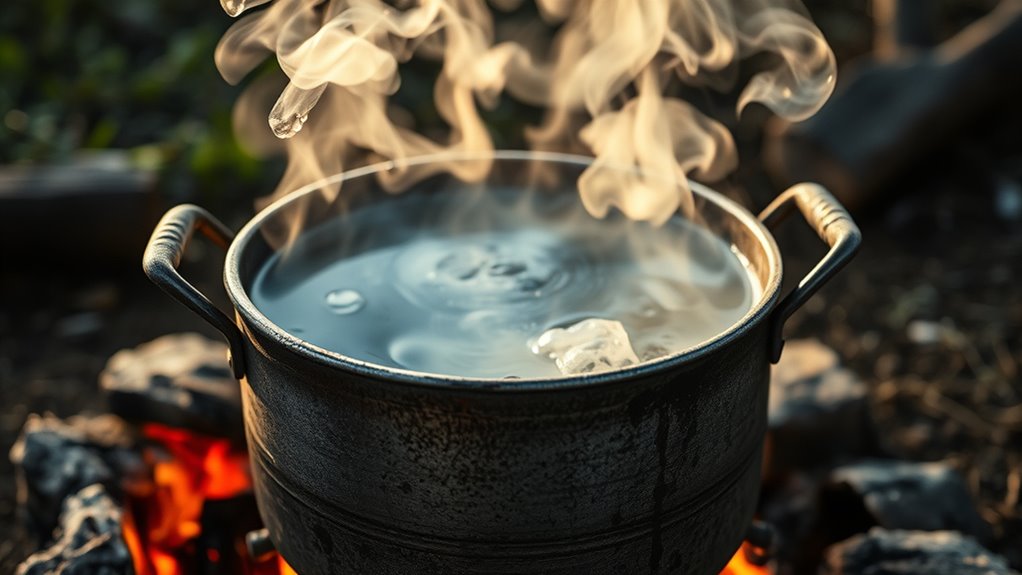
Boiling water stands out as one of the simplest and most reliable methods to guarantee safety, especially when other purification options aren’t available. By boiling water, you effectively disinfect it, killing most pathogens like bacteria, viruses, and protozoa that can cause illness. Typically, boiling for 1-3 minutes is enough to ensure purification, but at high altitudes, you should extend boiling beyond three minutes due to lower boiling temperatures. Remember to cover the water while boiling and let it cool before drinking to prevent recontamination. Keep in mind, boiling does not remove chemical contaminants or heavy metals, so it mainly enhances safety by disinfecting biological threats. This method is cost-effective, accessible, and ideal for emergency situations or outdoor water treatment. Additionally, using water purification technology can provide a more comprehensive approach to ensuring safe drinking water. Proper water treatment methods can help eliminate chemical impurities that boiling alone cannot address. Incorporating proper sanitation practices is also crucial to prevent recontamination during storage and handling. For optimal safety, combining boiling with other purification methods such as filtration or chemical disinfection is recommended when possible.
Filtration Techniques
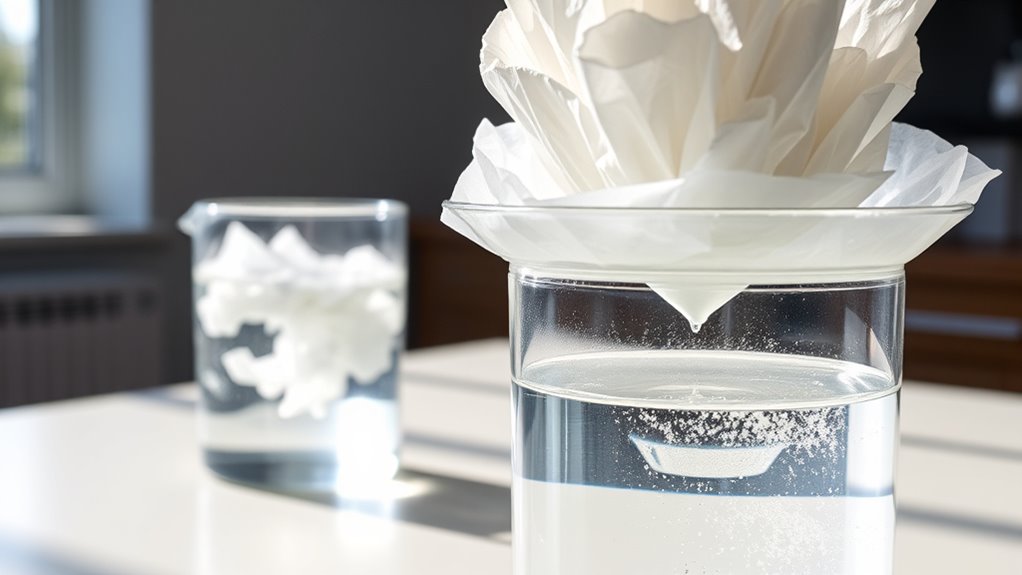
Filtration systems come in various types, each suited for different water treatment needs. You need to understand how they work and how to keep them effective through regular maintenance. Proper care guarantees your filters continue removing contaminants efficiently and safely. Additionally, implementing advanced water purification methods can further enhance water safety and quality. For example, integrating modern filtration technologies can significantly improve the removal of pollutants and pathogens.
Types of Filtration Systems
What are the different methods used to filter water effectively? Filtration systems employ various techniques to remove biological contaminants, suspended solids, and chemicals. For example: 1. Slow sand filters use a biological layer called biofilm that breaks down organic matter over time. 2. Ultrafiltration relies on membrane filtration to block bacteria and viruses, ensuring safer water. 3. Activated carbon filters adsorb chemicals and improve taste and odor. Each system serves a specific purpose: slow sand filters target biological contaminants, ultrafiltration provides high-level pathogen removal, and activated carbon reduces chemicals. Combining these methods enhances water safety and quality. Proper maintenance, like cleaning or replacing media, keeps the systems effective and prevents microbial buildup. Additionally, understanding the self-watering plant pots system can help in managing water quality for plants and ensure proper filtration. Proper filter media selection and replacement are crucial for maintaining optimal performance and extending the lifespan of filtration systems. Incorporating pre-treatment steps can further improve system efficiency and longevity. Implementing regular testing of water quality helps detect issues early and maintain safe drinking water standards.
Maintenance and Effectiveness
Regular maintenance is crucial to keep filtration systems working effectively and guarantee water remains safe to drink. Neglecting filter replacement or cleaning reduces filtering efficiency, allowing contaminants to slip through. Proper upkeep ensures maximum contaminant removal, maintaining water quality standards. When filters clog, flow slows, and microbial growth can occur, risking recontamination. Use the table below to guide your maintenance schedule:
| Filter Type | Maintenance Action | Frequency | Effect of Neglect | Expected Lifespan |
|---|---|---|---|---|
| Activated Carbon | Replace or clean | Every 6-12 months | Decreased contaminant removal | 6-12 months |
| Ultrafiltration | Clean or replace | Annually | Reduced filtering efficiency | 12-24 months |
| Sediment Filters | Rinse or replace | Every 3-6 months | Clogging, water flow issues | 3-6 months |
| Reverse Osmosis Membranes | Replace as recommended | 2-3 years | Impaired water quality | 2-3 years |
| UV Filters | Replace lamp annually | Annually | Reduced microbial control | 1 year |
Additionally, selecting appropriate filtration techniques can significantly improve the overall effectiveness of water purification systems. Proper maintenance also helps prevent bacterial growth, which can compromise water safety and system longevity.
Distillation Process
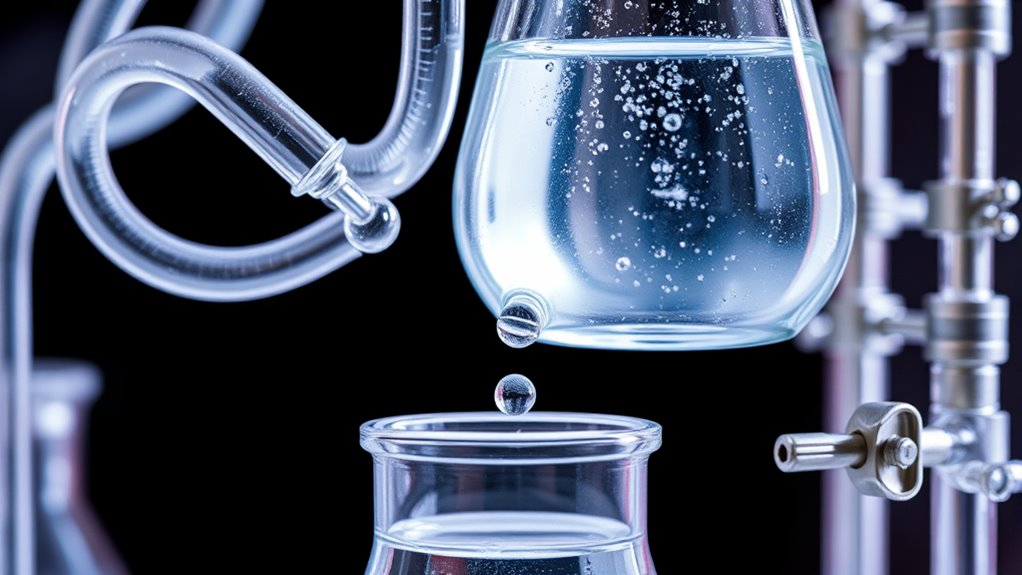
With distillation, you heat water until it vaporizes, leaving behind contaminants with higher boiling points. This method is highly effective at removing bacteria, heavy metals, and dissolved impurities, ensuring high purity. However, it requires significant energy and time, which can make it costly for large-scale use.
Heat and Vaporization
Heat and vaporization are key steps in the distillation process, where boiling water produces vapor that can be collected and condensed into purified liquid. When you heat water, it undergoes vaporization, turning into vapor as impurities with higher boiling points, like salts and heavy metals, stay behind. During distillation, the process involves:
- Heating water until it boils, creating vapor.
- Collecting the vapor free of contaminants.
- Condensing the vapor back into liquid for pure water.
This method effectively removes bacteria, viruses, and dissolved contaminants. The vapor carries the pure water molecules, leaving behind impurities and contaminants with higher boiling points. While energy-intensive, vaporization ensures high purity, especially useful for treating raw or contaminated water sources like seawater.
Contaminant Separation Efficiency
The distillation process is highly effective at separating a wide range of contaminants from water, making it one of the most thorough purification methods available. During distillation, you heat water until it evaporates, leaving behind impurities with higher boiling points. The vapor then passes through a condenser, where it cools and reverts to liquid, ensuring high purity. This process efficiently removes bacteria, viruses, salts, heavy metals like lead and mercury, and organic compounds, especially those with higher boiling points than water. Because evaporation separates contaminants based on boiling point differences, distillation achieves superior contaminant removal. Though energy-intensive, it ensures you get very pure water, suitable for sensitive applications. The process’s effectiveness makes distillation a top choice for comprehensive water purification.
Energy and Cost Considerations
Is distillation a cost-effective solution for water purification? Not necessarily, because it demands high energy consumption to heat water into vapor, impacting overall cost. The main factors influencing expenses include:
- The initial investment in distillation units
- Ongoing energy costs for operation
- Maintenance requirements due to system complexity
While renewable energy can reduce energy consumption, it often raises upfront costs. Compared to filtration or chlorination, distillation’s energy use and equipment maintenance make it less economical for large-scale or frequent purification. However, its high system efficiency in removing contaminants can justify costs for specific applications. Balancing energy consumption with system efficiency and exploring renewable energy options can improve cost-effectiveness, but careful consideration is essential before choosing distillation for your water purification needs.
Disinfection Methods
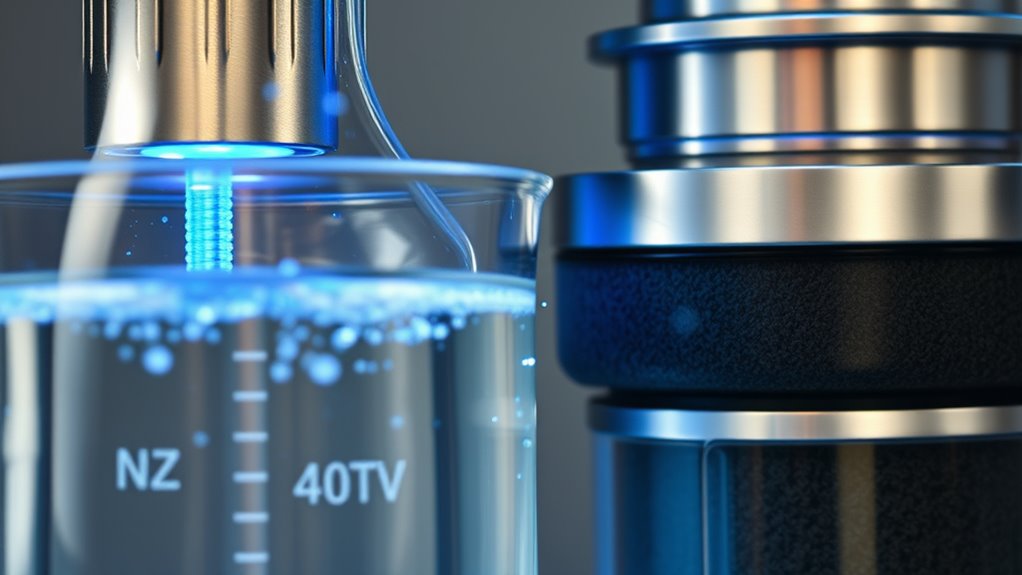
Disinfection methods play a crucial role in ensuring water safety by actively removing or inactivating harmful microorganisms. You can achieve this through disinfection techniques like chlorine, UV light, or ozone. Chlorine is a common choice, where you add a mild bleach solution or chlorine tablets to oxidize pathogens such as bacteria, viruses, and protozoa. UV disinfection uses ultraviolet light to damage the DNA or RNA of microorganisms, effectively inactivating them without chemicals. Ozone, a reactive molecule, removes pathogens efficiently and improves water safety without impacting taste or odor. Combining physical filtration with chemical or UV disinfection offers broad-spectrum protection. By choosing appropriate disinfection methods, you considerably reduce the risk posed by waterborne pathogens, ensuring safer drinking water for all.
Other Water Purification Options
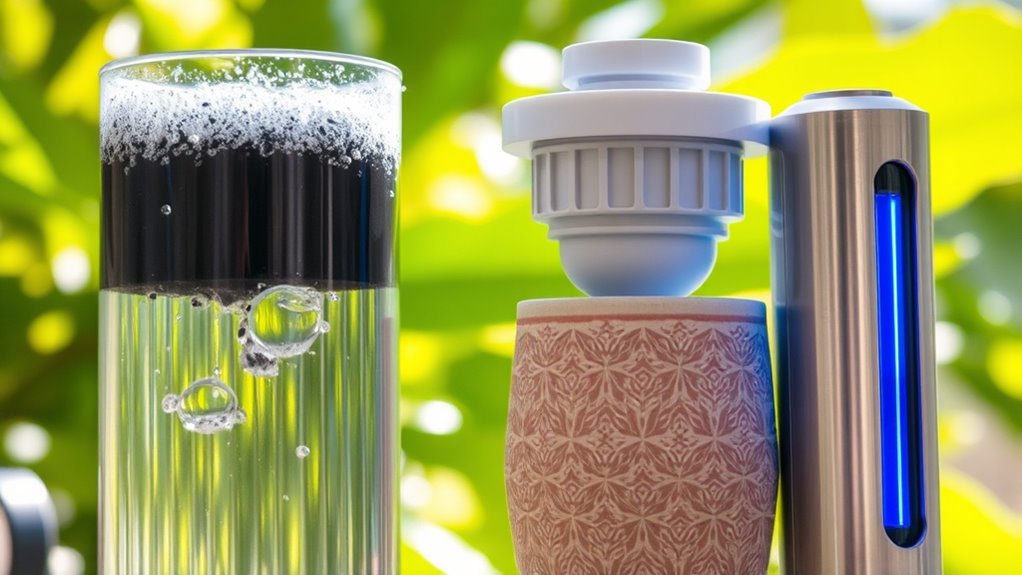
Have you considered alternative water purification methods beyond chemical treatments and physical filtration? These options use innovative techniques to make contaminated water safe. For example,:
- UV radiation disinfects water efficiently, killing bacteria and viruses without chemicals.
- Distillation involves boiling water and collecting the vapor, removing most contaminants.
- Atmospheric water generators extract moisture from the air, providing clean drinking water even in arid regions.
These methods can be combined with traditional filtration or chemical disinfection to enhance safety. UV radiation is especially useful for rapid treatment, while distillation is effective against chemical pollutants. Atmospheric water generators offer a sustainable solution when surface water sources are scarce. Exploring these options helps you access safe water in diverse circumstances.
Summing Up

Understanding the full range of water purification methods helps you make informed choices for safe drinking water. Water purification includes techniques like filtration, boiling, distillation, chemical disinfection, and advanced methods such as UV and ozone treatment. Combining these methods effectively removes contaminants—biological, chemical, and physical—ensuring the water is safe to drink. Each technique has its advantages and limitations, so selecting the right method depends on your water source and specific needs. Proper treatment not only meets safety standards but also markedly reduces the risk of waterborne diseases. Innovations in water purification continue to improve water quality worldwide, making safe drinking water more accessible. By understanding and applying these methods, you can protect yourself and your community from water-related health issues.
Frequently Asked Questions
What Are the 5 Methods of Water Purification?
You’re asking about the five main ways to make water safe to drink. First, you can boil it, which kills germs. Second, filtration removes solids and chemicals. Third, distillation separates impurities by vaporizing and condensing water. Fourth, chlorination uses chemicals to eliminate bacteria and viruses. Finally, UV disinfection uses ultraviolet light to destroy pathogens. Each method works differently, so choose based on your needs and available resources.
What Are the 10 Ways to Purify Water?
Think of water purification as a toolbox—there are 10 ways to make your water safe. You can boil it, filter it, use chemical disinfectants, or shine UV light on it. Distillation heats and captures vapor, while sedimentation lets particles settle. You might also try solar disinfection, ozonation, or ion exchange. Each method acts like a different key, releasing safe drinking water in various situations.
What Is the Best Method to Purify Water?
When considering the best way to purify water, you should choose a method that matches your needs. Boiling water is simple and reliable for killing pathogens, while reverse osmosis offers thorough removal of chemicals and contaminants. UV treatment is quick and chemical-free, and activated carbon filters improve taste and remove pesticides. Often, combining methods like filtering then boiling or UV treatment gives you the safest, cleanest water possible.
What Is the Best Purification Treatment of Drinking Water?
When considering the current question, you want a treatment that truly transforms tap water into safe, satisfying sips. Combining clever methods like carbon filtration for clarity, reverse osmosis for removal of salts and chemicals, and UV disinfection for biological safety creates the best purification blend. You’ll enjoy water that’s clean, clear, and completely safe, giving you peace of mind with every invigorating, reliable drink.
Conclusion
Think of water as life’s silent messenger, carrying stories from source to you. By understanding purification methods, you’re not just cleaning water—you’re safeguarding your future. Every step you take, from testing to treating, acts as a shield against unseen threats. Embrace these techniques like keys to a hidden treasure, ensuring pure, safe water flows into your life. Protect this essential gift, for it’s the symbol of health, hope, and the rhythm of life itself.

